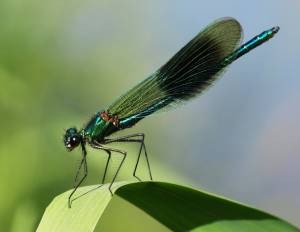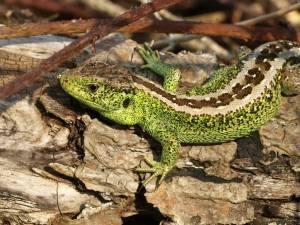Dr Phil Smith’s Wildlife Notes
May 2007
May is often one of the best months for wildlife and that of 2007 was no exception. By the end of the month, I had found eight species of dragonfly locally – an unprecedented total so early in the season, several being the earliest ever recorded in north Merseyside. One of the easiest and most spectacular to see is the Banded Demoiselle (Calopteryx splendens), a large metallic-blue insect with dark-blue bands across the wings. In sunny weather using binoculars, you can watch it from Moss Side bridge over Downholland Brook. The presence of this, and other pollution-sensitive wildlife, reflects a dramatic recent improvement in water-quality on the drainage system inland of Formby and Southport, for which local farmers and the Environment Agency are to be congratulated.

At this time of year, I always try to go on one of the organised visits to Altcar Rifle Range to see the wild orchids. Despite torrential rain, the 16th May walk was a revelation with an unforgettable display of around 15,000 Green-winged Orchids (Orchis morio). This is the largest colony of this nationally declining species in the north of England, its success being assured by not mowing its damp grassland habitat until mid-July. This also encourages pink swathes of Ragged-Robin (Lychnis flos-cuculi), a true indicator of wet meadows, which has sadly declined in the wider countryside due to drainage and agricultural “improvement”. By the following week, the Green-wings had been joined by an abundance of Northern Marsh-orchids (Dactylorhiza purpurella), including some hybrids which may be new to the coast. To determine these, photographs will have to be sent to the national orchid expert, Prof. R.M.Bateman, at the Natural History Museum, London.
Another good find was Prickly Poppy (Papaver argemone) spotted by Dave Earl at Formby Station carpark. This striking plant was last recorded in the Formby area as long ago as 1873!
The Trans-Pennine Trail, developed by Sustrans along the route of the former Cheshire Lines railway, provides an attractive inland walk not far from Formby. A morning stroll on 13th May was enlivened by lots of singing warblers, including Blackcap, Whitethroat, Willow Warbler and Sedge Warbler, while the flowery verges made a pleasant contrast to the nearby rather monotonous arable crops. A solitary ploughed field had attracted a flock of 22 Whimbels; this smaller version of the Curlew stops off in our area every spring on its migration from Africa to breeding haunts in northern Europe, including Shetland. Numbers have been good this spring, Derek Williams reporting up to 159 at several mossland sites.
I managed to miss arguably Sefton’s “best” bird of the month, a vagrant Woodchat Shrike from southern Europe at Marshside on 20th May. I was out monitoring Natterjack Toads at Birkdale Green Beach, where 176 spawn strings so far is a record count for this increasingly important breeding site.
The last few years have seen a five-fold increase in sightings of one of our most charismatic and elusive wild creatures, the Sand Lizard. Being separated by about 200 miles from the next nearest ones in southern England, the Sefton Coast population has evolved a distinct colour-form, the males being a stunning lime-green. Down south, they are a duller bottle-green. Warmer summers and conservation efforts mean there is now a better chance of seeing one in the wild than for 40 years. With a little help, I managed to catch up with five Sand Lizards in the last few days of May – a real highlight of my spring in the sand-dunes!

